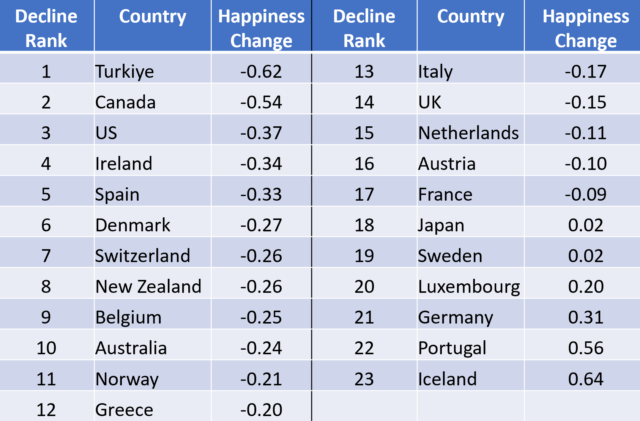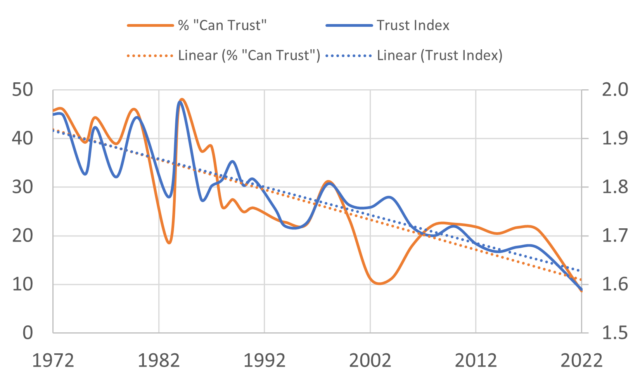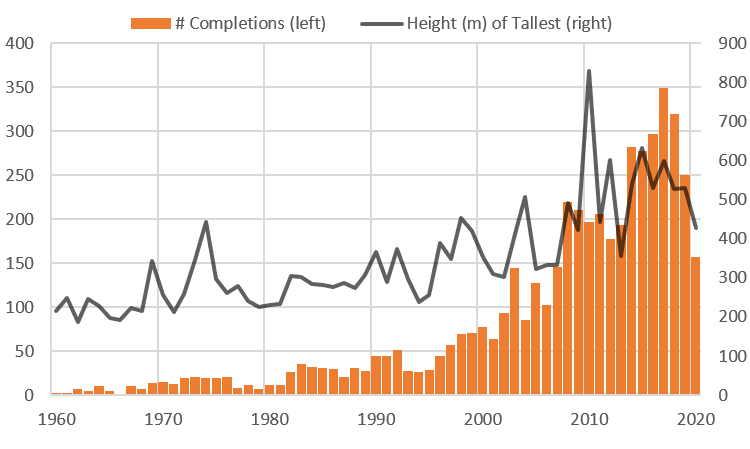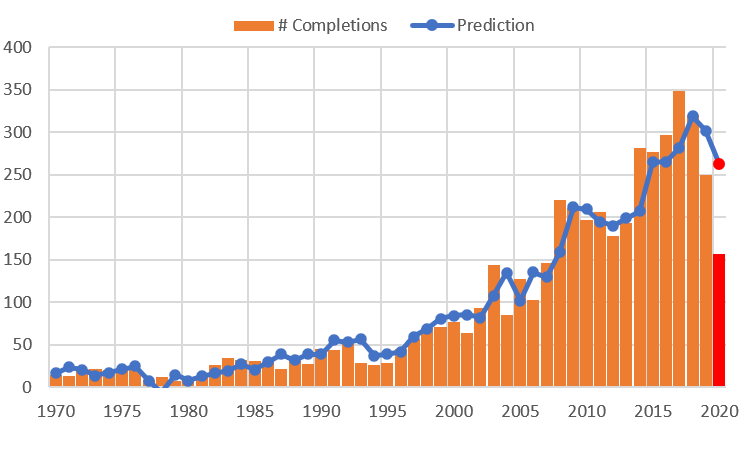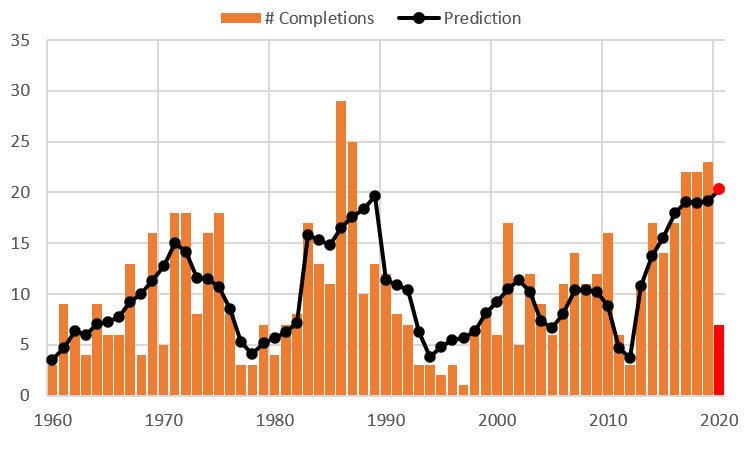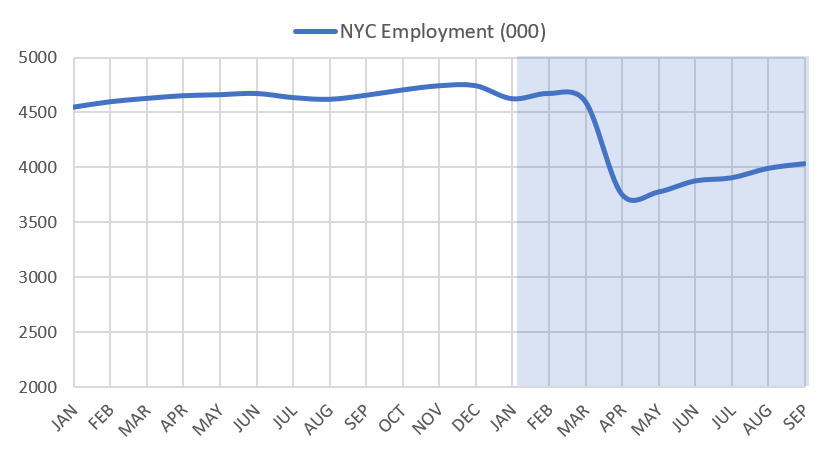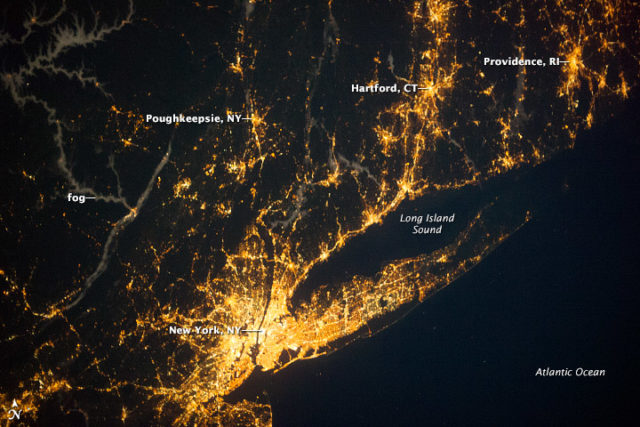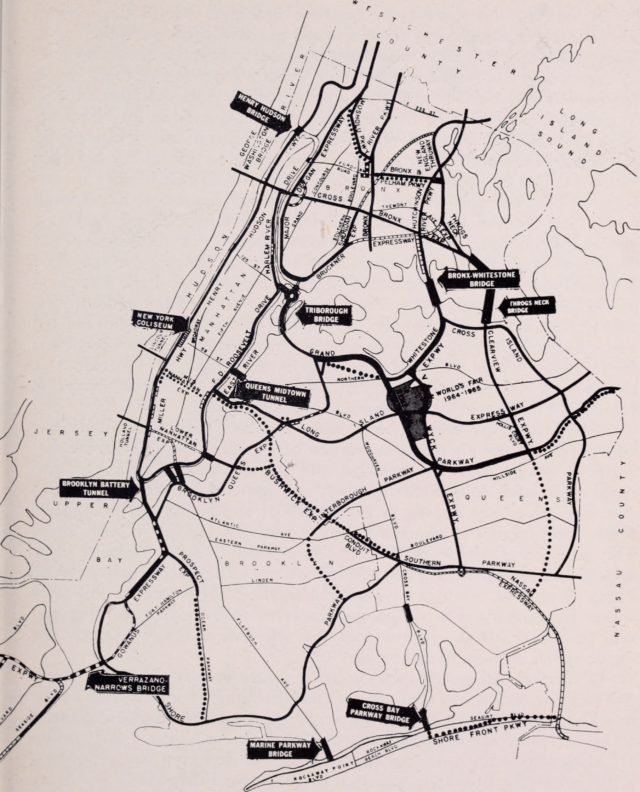Jason M. Barr May 7, 2024
On May 14, my book Cities in the Sky: The Quest to Build the World’s Tallest Building was released by Scribner Books. You can order a copy and sign up for my email list here.
Cities in the Sky tours the world’s greatest cities, from Chicago to New York to London and then to Asian metropolises, to see why they are building their skylines. Along the way, the book busts myths and misconceptions about skyscrapers. Cities in the Sky addresses the good, bad, and ugly for cities that have embraced vertical skylines, offering a glimpse into the future to see whether cities around the world will continue their journey upward.
“With a global view and his eyes cast skyward, Barr provides an enjoyable, expansive study of a subject he loves.” —Kirkus Reviews
Ever Upward
Skyscrapers remain controversial in the 21st century, yet they’re becoming more numerous and taller. Since 2000, seven times more skyscrapers (150 m/492 ft. or taller) have been completed worldwide than in the entire 20th century.
The Empire State Building, the world’s tallest structure for 40 years, is now ranked 53rd. The Willis (Sears) Tower was the record holder from 1974 to 1998, but today, it ranks a mere 25th. The Burj Khalifa, the current world’s tallest, is twice as tall as the Empire State Building, at 828 meters (one-half mile).
We are climbing our way to the heavens.
Why Do We Build Upward?
But why do we build upward? The short answer is that the humans of Planet Earth have been getting wealthier. In 1960, per capita gross domestic product (GDP) was $3,600. Today it’s over $11,000. Intimately tied to this economic growth is the corresponding rise in urbanization. In 1960, the world population was three billion, with two out of three people living in rural areas. Today, the world population is eight billion, and nearly 60% of us live in urban areas. In other words, six decades ago, the world’s cities housed one billion people. Today, they hold nearly five times that amount. Urbanized living is our present and future.
And why do these cities exist? Because they are our economic, social, and cultural engines. Manhattan alone—a mere 23 square miles—generates 3.3% of the United States Gross Domestic Product (GDP). Shanghai accounts for 3.7% of China’s GDP, while London generates a whopping 20% of the U.K.’s GDP.

The Ecosystem
People move to the cities for jobs but stay for socializing, education, and consumption. In this way, vibrant cities generate positive feedback loops. Companies set up shop and hire workers, who then spend their income on food, clothing, shelter, and fun. Their money circulates locally, creating more jobs, and so on. Vibrant economies attract more people and companies, and the economic growth continues. Density also creates a whole host of positive spillovers—people learn from each other and become more productive, and cities can offer a wider variety of goods and services than otherwise.
But what is a city? It’s fundamentally an ecosystem—a place where people live and work, along with the institutions that support them: buildings, transportation, access to goods and services, social networks, governmental services, and so on. If we want to understand why so many skyscrapers are rising, we must see them as one component of the urban ecosystem.
Since cities are dense clusters of humans who frequently want to be at the same place at the same time because of a location’s convenience to other people or amenities, the only way to accommodate this demand is to go upward. To take an example, a quarter-acre (1,012 m2) lot can reasonably shelter 25 people. But if the location is in high demand, then stacking those shelters by creating 20 “lots” (i.e., floors) on top of each other can hold 500 souls. The skyscraper pinches geography by producing land in the sky.
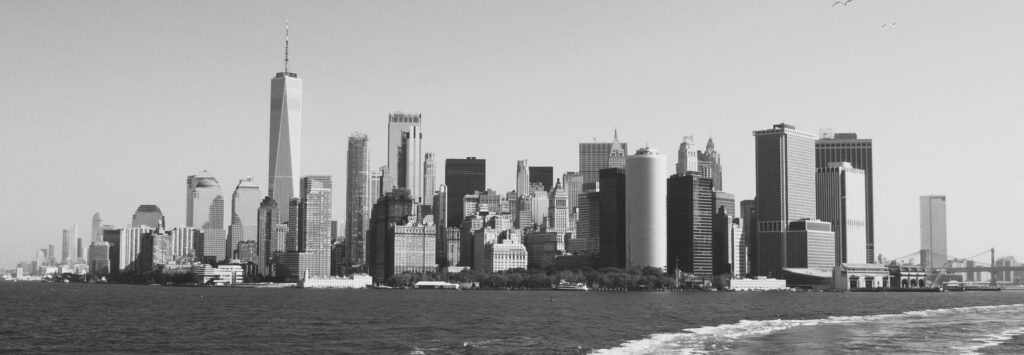
Cities in the Sky
Chicago, 1885
In Cities in the Sky, I take a global view to put the skyscraper in a larger historical context. In Part I, I begin with the birth and growth of the tall building in the late 19th century and early 20th century. First, we visit Chicago in the 1880s to see if the Windy City was really the birthplace of the skyscraper, as the conventional wisdom would have you believe. The answer is not so clear—New York and Chicago were each developing the technologies at about the same time.
But what is definitely true is that the Home Insurance Building (1885), designed by William Le Baron Jenney, was NOT the first skyscraper. Instead, its designation as such resulted from a public relations campaign by the Chicago School architects who decided to circle the wagons around Jenney because they wanted to box out other claimants.
New York, the Roaring Twenties
Then, from Chicago, it’s off to Roaring Twenties Gotham, where we visit the Empire State Building and chronicle its rise to become the world’s tallest building. Though the building was half empty during the Depression and was labeled the “Empty State Building,” the truth is that the building has been very profitable over the long run. The skyscraper was not so much a vision of grandeur but rather a grander vision that benefited Gotham and has served as an inspiration to the rest of the world.
Just as crucial for skyscraper history was New York’s implementation of zoning regulations, which paved the way for cities to find a balance between the benefits of tall buildings and regulating some of their downsides, like shadows and congestion. The 1916 codes incentivized the wedding cake style because skyscrapers had to be set back as they rose to allow more sunlight on the street. The regulations inspired the Art Deco aesthetic, the second modernist movement after the Chicago School of Architecture.
In 1961, New York implemented a new set of codes by regulating the so-called Floor Area Ratio (FAR), which limited the amount of floor area that could be built on each lot. The FAR was popular, and today, it is arguably the most important skyscraper regulation worldwide. By regulating building bulk, the FAR encouraged the third modernist architectural style, the International Style glass box tower.
Post-War America
Then, we visit post-war America. The real “hero” of the skyscraper after World War II was the computer. For the first time in human history, computers could be used to work out the physics of tall buildings. They allowed architects and engineers to devise strategies to go taller for lower costs. The computer thus led to what I call the Second Skyscraper Revolution, a new suite of technologies and design methods that gave rise to the next crop of the world’s tallest buildings, the Twin Towers (1972/3) in New York City and the Sears (Willis) Tower (1974) in Chicago.
And just as important for world history, America demonstrated that growing cities needed tall buildings to house their companies and to signal their economic might. By the late 1990s, the skyscraper spread like a wave across the rest of the planet. In Part II of the book, we take a grand global tour.
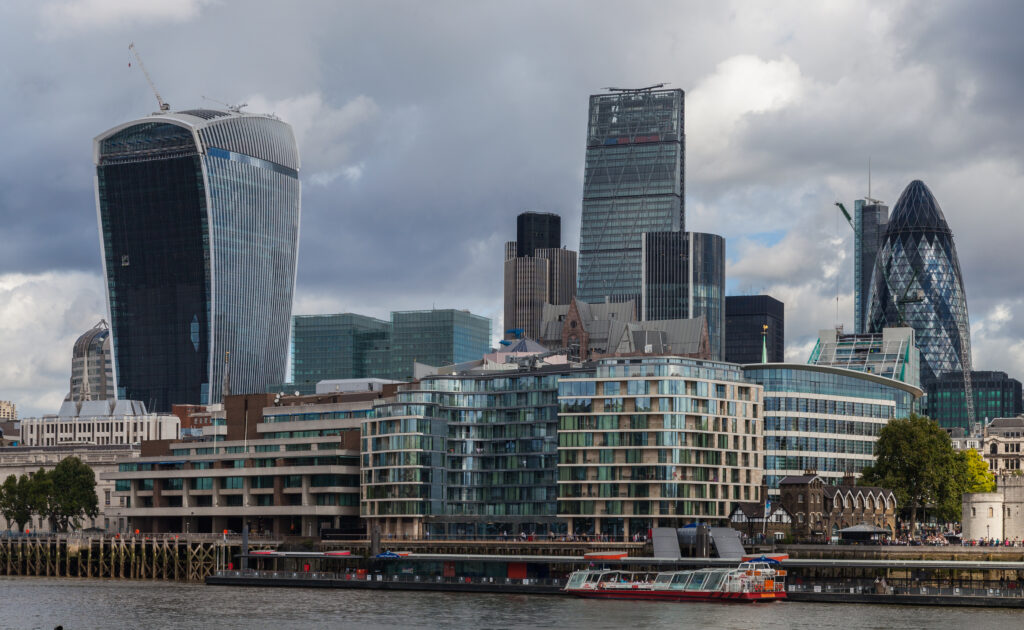
London: From No to Yes
The next stop is London, which provides a fascinating case study regarding tall buildings. In 1894, just as all the technologies needed to produce skyscrapers became available, London banned them by instituting a height cap of 80 feet. If you ask architectural historians why this is so, they will invariably say that the conservative London architects, who sought to preserve the U.K.’s imperial tradition of classical buildings, would not deign to build new-fangled towers like their Yankee upstarts across the pond.
While this is true to a degree, when we drill down into the economics of London’s business district, we see it had something New York did not have: space. The City of London was able to accommodate its business growth because it had more land. The conservatives and anti-skyscraperists were able to hold sway because the economic pressures were never as intense as in Lower Manhattan or Chicago’s Loop.
Then, during the 20th century, after the Blitz Bombing, much of London’s building stock was destroyed, and the city could be rebuilt without supertall towers. But all that changed in the 21st century. London was running out of space, and the answer was to go upward with iconic skyscrapers—the Gherkin, the Cheesegrater, the Shard, and the Walkie-Talkie, to name a few.
Living Densely in Hong Kong
The next stop is Hong Kong, where we see how it became the densest city on the planet with the highest concentration of skyscrapers anywhere. The reason is due to is combination of land shortages, its history as a British-controlled Chinese city, and its unique land ownership system.
Hong Kong was always “land poor”—being mostly hilly territory. When mainland turmoil hit, Chinese residents flooded the colony, seeking employment and refuge. After World War II, British officials realized the only way to accommodate the deluges and to keep the colony profitable was to build upward. The process began with public housing, which, unlike in the U.S., has proved an enduring success. Officials then invested in mass transit and horizontal connectivity to make Hong Kong truly a 3D city.
China: Skyscraper Fever
Then off to mainland China, which has undertaken the largest skyscraper construction project in human history. There is no way else to put this except to say that China has “Skyscraper Fever.” The massive urbanization that has unfolded since the economic reforms initiated in 1978, combined with its particular method of governance, has led China to embrace the tall building bling like no other country.
But its love of the skyscraper has come with a cost. Today, China’s real estate market is in desperate straits because of the overbuilding. Leaders are scrambling to contain the damage. And in 2020, the Community Party banned buildings taller than 500 meters (1,640 feet), and dramatically reduced the number of buildings above 150 meters (492 feet). But if there is one key lesson in skyscraper history, it’s that gluts eventually lead to shortages and shortages back to booms. Stay tuned…
Arabian Heights
After China, we head to the Arabian Peninsula to visit the world’s tallest building, the Burj Khalifa, at 828 meters (0.5 miles) tall. While most people see this building as an example of the craving for spectacle and egos gone wild, the truth is a bit more complex. Yes, the structure was built during a real estate boom, but its construction was meant to help put Dubai on the map as a business and tourist destination.
When we look at the economics of the project, we can see that it represents the same kind of maniacal genius that gave rise to the Empire State Building. Seventy percent of the tower’s residential units sold out before the crash; the observatory is a cash cow, and the surrounding properties with a Burj view are worth thousands of dollars more because of that view.
The tower’s success has not been lost on Saudi Arabia, which realizes it must move quickly to wean itself off its oil addiction. The crown prince, Mohammed bin Salman, is using mega projects to lift the country by its bootstraps. In 2010, the nation started to build the world’s tallest building, the Jeddah Tower, but then political turmoil led to its halt. If restarted, it will be the world’s tallest tower at one kilometer (0.62 miles).
In the meantime, the kingdom is building other mega projects like The Line, which is proposed to be 500 meters (1640 feet) high, 200 meters (656 feet) wide, and 170 kilometers (106 miles) long to house nine million people! Will Saudi Arabia succeed in this unbelievable project? It’s hard to say, but the truth is that great cities typically spring from the ground up and not from the spire downward.
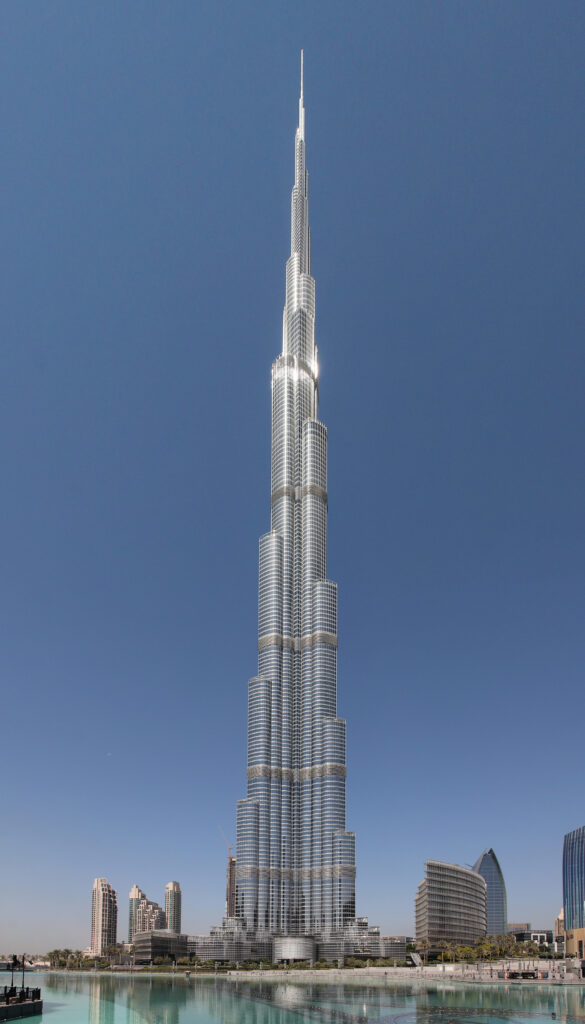
A Global View
In Part III, we take a step back to look at the good, bad, and ugly of tall buildings, asking why we are building them, how they should be regulated, and what’s in store for the future.
The reason tall buildings are growing worldwide is the benefits they provide. They allow us to more easily enjoy the fruits of the city, and provide amazing views. But why is the idea of stacking people—the creation of high-rises—so controversial? One claim—particularly in Western cities—is that they seem to generate gentrification, displacement, and inequality. There is some truth to this, but the real story is more complex and nuanced.
Gentrification and luxury condos must be understood within the larger economic context. Income inequality, for example, should be addressed by making tax rates much more progressive and improving employment opportunities for those at the bottom of the economic ladder. Housing affordability needs to be improved by building abundant housing for everyone—across the income spectrum and entire metropolitan regions.
If more housing is built in the suburbs and that lowered land values in the center, we might get fewer tall buildings there. And that’s perfectly good and right. While new supply everywhere helps, it’s more critical to build affordable housing where it’s most needed. Similarly with CO2 production, yes tall buildings emit a lot of CO2, but overly stringent regulations that cap heights, for example, generate sprawl, which is even more carbon intensive. Policies need to tax carbon for all producers and subsidize clean energy production.
The Future
Over the long run, however, as technology has progressed, we can erect buildings that are not only taller but are also more functional—and for lower costs. The improved supply conditions combined with the rising tide of urbanization means that taller and taller buildings will continue to be brought forth in the world’s greatest cities. But at the end of the day, cities succeed when they bring us together and make us more productive. If designed well and built in the right locations, skyscrapers can help us achieve that goal.
You can order Cities in the Sky: The Quest to Build the World’s Tallest Skyscrapers here.



